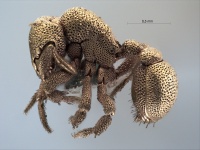Eurhopalothrix seguensis
| Eurhopalothrix seguensis | |
|---|---|

| |
| Scientific classification | |
| Kingdom: | Animalia |
| Phylum: | Arthropoda |
| Class: | Insecta |
| Order: | Hymenoptera |
| Family: | Formicidae |
| Subfamily: | Myrmicinae |
| Tribe: | Attini |
| Genus: | Eurhopalothrix |
| Species: | E. seguensis |
| Binomial name | |
| Eurhopalothrix seguensis Taylor, 1990 | |
The single type specimen, a worker, was collected from from rainforest leaf mould berlesate.
Identification
Mezger & Pfeiffer (2010) - Separated from all other species by combination of four distinct setae on posterior section of head. Medium pair of these setae close together at midline of head, other pair wider sepa-rated and closer to occiput. Each of these setae 0.04 mm long. Postpetiole with one seta at each side. Eye with 20 ommatidia. Ground pilosity less dense with mean distance of squamiform hairs 18 μm and diameter of foveolae around 28 μm, i.e., distances between squamiform hairs large and resembling Eurhopalothrix elke, but diameter of foveolae more similar to Eurhopalothrix platisquama. Scape with two rows of setae, one outer row with seven setae and one inner row with nine setae (Fig. 16). Mandible 1.1 times as broad as long. Due to extensive gold-coverage for former SEM studies no information on number of teeth available.
Keys including this Species
Distribution
Latitudinal Distribution Pattern
Latitudinal Range: 1.55° to 1.55°.
| North Temperate |
North Subtropical |
Tropical | South Subtropical |
South Temperate |
- Source: AntMaps
Distribution based on Regional Taxon Lists
Indo-Australian Region: Borneo (type locality), Indonesia, Malaysia.
Distribution based on AntMaps
Distribution based on AntWeb specimens
Check data from AntWeb
Countries Occupied
| Number of countries occupied by this species based on AntWiki Regional Taxon Lists. In general, fewer countries occupied indicates a narrower range, while more countries indicates a more widespread species. |

|
Estimated Abundance
| Relative abundance based on number of AntMaps records per species (this species within the purple bar). Fewer records (to the left) indicates a less abundant/encountered species while more records (to the right) indicates more abundant/encountered species. |

|
Biology
|
Castes
Nomenclature
The following information is derived from Barry Bolton's Online Catalogue of the Ants of the World.
- seguensis. Eurhopalothrix seguensis Taylor, 1990b: 421, figs. 34, 41-43, 55 (w.) BORNEO.
Unless otherwise noted the text for the remainder of this section is reported from the publication that includes the original description.
Description
Worker
All Class A attributes present, with those of Class B, unless otherwise indicated. Dimensions (mm): HL 0.71; HW 0.79; CI 112; ML 0.19; MI 27; SL 0.41; SI 52; PW 0.48; WL 0.83. Eyes large, as in Eurhopalothrix platisquama. Occipital border almost straight, transverse (its outline at most minutely curved or sinuous). Posterior occipital angles obtusely rounded, forming angles of about 130°. Mesosomal profile not a continuous curve, its outline interrupted at the promesonotal/propodeal junction by a minute indentation; the mesometanotal suture not incised dorsally to break the surrounding sculpture. Petiolar node in dorsal view essentially square, its length and breadth sub equal (bias transverse).
Frons and most dorsal body surfaces with ground pilosity of dense, flattened, appressed, squamous, shining silvery hairs, which are less strongly developed than in E. platisquama and Eurhopalothrix dubia, so as barely to overlap the punctures in which they lie, which remain more clearly visible than in the other species mentioned. Four relatively short specialised hairs on posterior occipital border, the median pair adjacent, the laterals each about midway between them and the posterior occipital angles; the hairs clavate, barely expanded, though somewhat thick and columnar. Erect hairs lacking elsewhere on promesonotum, petiolar node and dorsum of first gastral tergite; one pair (posterolateral) on postpetiole.
Type Material
Malaysia: Sarawak: First Division: Kampong Segu, 20 miles S.W. of Kuching (01°33'N.,110°20'E.). Known only from the unique worker holotype, from a rainforest leaf mould berlesate (RWT acc 68 .289, 4.vi.1968). In Australian National Insect Collection (type No. 7783); gold-palladium coated for SEM study.
Etymology
Named for the type locality.
References
- Taylor, R. W. 1990c. New Asian ants of the tribe Basicerotini, with an on-line computer interactive key to the twenty-six known Indo-Australian species (Hymenoptera: Formicidae: Myrmicinae). Invertebr. Taxon. 4: 397-425
References based on Global Ant Biodiversity Informatics
- Mezger, D.; Pfeiffer, M. 2010. Eurhopalothrix elke, a new species from Borneo, and a key to the species of the E. platisquama group (Hymenoptera: Formicidae). Myrmecological News 13:133-139.
- Pfeiffer M.; Mezger, D.; Hosoishi, S.; Bakhtiar, E. Y.; Kohout, R. J. 2011. The Formicidae of Borneo (Insecta: Hymenoptera): a preliminary species list. Asian Myrmecology 4:9-58
- Taylor R. W. 1990. New Asian ants of the tribe Basicerotini, with an on-line computer interactive key to the twenty-six known Indo-Australian species (Hymenoptera: Formicidae: Myrmicinae). Invertebrate Taxonomy 4: 397-425.

